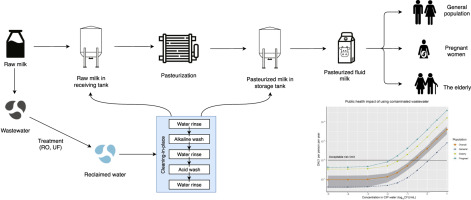当前位置:
X-MOL 学术
›
Water Res.
›
论文详情
Our official English website, www.x-mol.net, welcomes your feedback! (Note: you will need to create a separate account there.)
Risk-based assessment and criteria specification of the microbial safety of wastewater reuse in food processing: Managing Listeria monocytogenes contamination in pasteurized fluid milk.
Water Research ( IF 12.8 ) Pub Date : 2020-01-03 , DOI: 10.1016/j.watres.2020.115466 Onay B Dogan 1 , Yulie E Meneses 2 , Rolando A Flores 3 , Bing Wang 1
Water Research ( IF 12.8 ) Pub Date : 2020-01-03 , DOI: 10.1016/j.watres.2020.115466 Onay B Dogan 1 , Yulie E Meneses 2 , Rolando A Flores 3 , Bing Wang 1
Affiliation

|
Intense pressure on water resources has led to efforts to reuse reclaimed processing wastewater for cleaning purposes in food processing plants. The milk industry produces considerable amounts of wastewater, which can be used for cleaning of equipment after appropriate treatment. However, due to naturally occurring microbiological contamination in raw milk, the wastewater is often contaminated, and therefore the reuse of reclaimed wastewater is perceived as risky. This study aims to quantify the risks of Listeria monocytogenes infection and associated disease burden when wastewater reclaimed from milk processing operations is used in cleaning-in-place (CIP) systems for pasteurized fluid milk production following a quantitative microbial risk assessment (QMRA) approach. Furthermore, this study aims to inform risk-based tolerable limits for levels of contamination in CIP water based on a public health target of 10-6 DALY per person annually. The suggested model investigates the passage of L. monocytogenes throughout the fluid milk chain, from receipt of raw milk at the plant to the point of consumption and covering storage in receiving and storage tanks, pasteurization, and storage at retail and at home. Risk and disease burden estimates are simulated for general (younger than 65 years), elderly (65 years and older) and pregnant population subgroups. Additional scenarios covering the effect of using clean water, using water with different levels of contamination and using reclaimed wastewater modeled as recovered from cheese whey after membrane filtration (reclaimed water scenario) are considered to estimate a risk-based limit of contamination and simulate a real-life example. The tolerable limit of contamination in CIP water was estimated as -2 log10 CFU/mL to ensure the protection of the most vulnerable subgroup, pregnant women, while higher limits were estimated for the elderly and general subgroups. Under the reclaimed water scenario, the annual number of listeriosis cases was estimated as 3.36, 5.67, and 0.15 for the general, elderly and pregnant population subgroups, respectively, while in the clean water scenario, the estimates were 3.33, 5.56 and 0.15, respectively. In both scenarios, the DALY estimates were lower than the tolerable limit. The results indicate that reclaimed water can be an alternative to potable water for CIP applications.
中文翻译:

食品加工中废水再利用微生物安全性的基于风险的评估和标准规范:管理巴氏杀菌液态奶中的单核细胞增生李斯特菌污染。
对水资源的巨大压力促使人们努力在食品加工厂中将回收的加工废水用于清洁目的。牛奶行业产生大量废水,经过适当处理后可用于设备清洗。然而,由于生乳中天然存在微生物污染,废水经常受到污染,因此回收废水的再利用被认为是有风险的。本研究旨在通过定量微生物风险评估 (QMRA) 方法将牛奶加工操作中回收的废水用于巴氏杀菌液态奶生产的就地清洗 (CIP) 系统时,量化李斯特菌感染和相关疾病负担的风险。此外,本研究旨在根据每人每年 10-6 DALY 的公共卫生目标,为 CIP 水中的污染水平提供基于风险的可容忍限值。建议的模型研究了单核细胞增生李斯特菌在整个液态奶链中的传播,从工厂接收原料奶到消费点,并涵盖在接收和储存罐中的储存、巴氏杀菌以及零售和家庭储存。模拟了一般(65 岁以下)、老年人(65 岁及以上)和怀孕人群亚组的风险和疾病负担估计。涵盖使用清洁水的效果的其他场景,使用具有不同污染程度的水和使用模拟为从膜过滤后从奶酪乳清中回收的再生废水(再生水方案)被认为是估计基于风险的污染限制并模拟现实生活中的例子。CIP 水中污染的容许限度估计为 -2 log10 CFU/mL,以确保对最脆弱的亚组孕妇的保护,而对老年人和一般亚组估计更高的限度。在再生水情景下,一般人群、老年人群和孕妇人群亚组的年李斯特菌病病例数估计分别为 3.36、5.67 和 0.15,而在清洁水情景中,估计值分别为 3.33、5.56 和 0.15 . 在这两种情况下,DALY 估计值均低于可容忍限度。
更新日期:2020-01-04
中文翻译:

食品加工中废水再利用微生物安全性的基于风险的评估和标准规范:管理巴氏杀菌液态奶中的单核细胞增生李斯特菌污染。
对水资源的巨大压力促使人们努力在食品加工厂中将回收的加工废水用于清洁目的。牛奶行业产生大量废水,经过适当处理后可用于设备清洗。然而,由于生乳中天然存在微生物污染,废水经常受到污染,因此回收废水的再利用被认为是有风险的。本研究旨在通过定量微生物风险评估 (QMRA) 方法将牛奶加工操作中回收的废水用于巴氏杀菌液态奶生产的就地清洗 (CIP) 系统时,量化李斯特菌感染和相关疾病负担的风险。此外,本研究旨在根据每人每年 10-6 DALY 的公共卫生目标,为 CIP 水中的污染水平提供基于风险的可容忍限值。建议的模型研究了单核细胞增生李斯特菌在整个液态奶链中的传播,从工厂接收原料奶到消费点,并涵盖在接收和储存罐中的储存、巴氏杀菌以及零售和家庭储存。模拟了一般(65 岁以下)、老年人(65 岁及以上)和怀孕人群亚组的风险和疾病负担估计。涵盖使用清洁水的效果的其他场景,使用具有不同污染程度的水和使用模拟为从膜过滤后从奶酪乳清中回收的再生废水(再生水方案)被认为是估计基于风险的污染限制并模拟现实生活中的例子。CIP 水中污染的容许限度估计为 -2 log10 CFU/mL,以确保对最脆弱的亚组孕妇的保护,而对老年人和一般亚组估计更高的限度。在再生水情景下,一般人群、老年人群和孕妇人群亚组的年李斯特菌病病例数估计分别为 3.36、5.67 和 0.15,而在清洁水情景中,估计值分别为 3.33、5.56 和 0.15 . 在这两种情况下,DALY 估计值均低于可容忍限度。


























 京公网安备 11010802027423号
京公网安备 11010802027423号